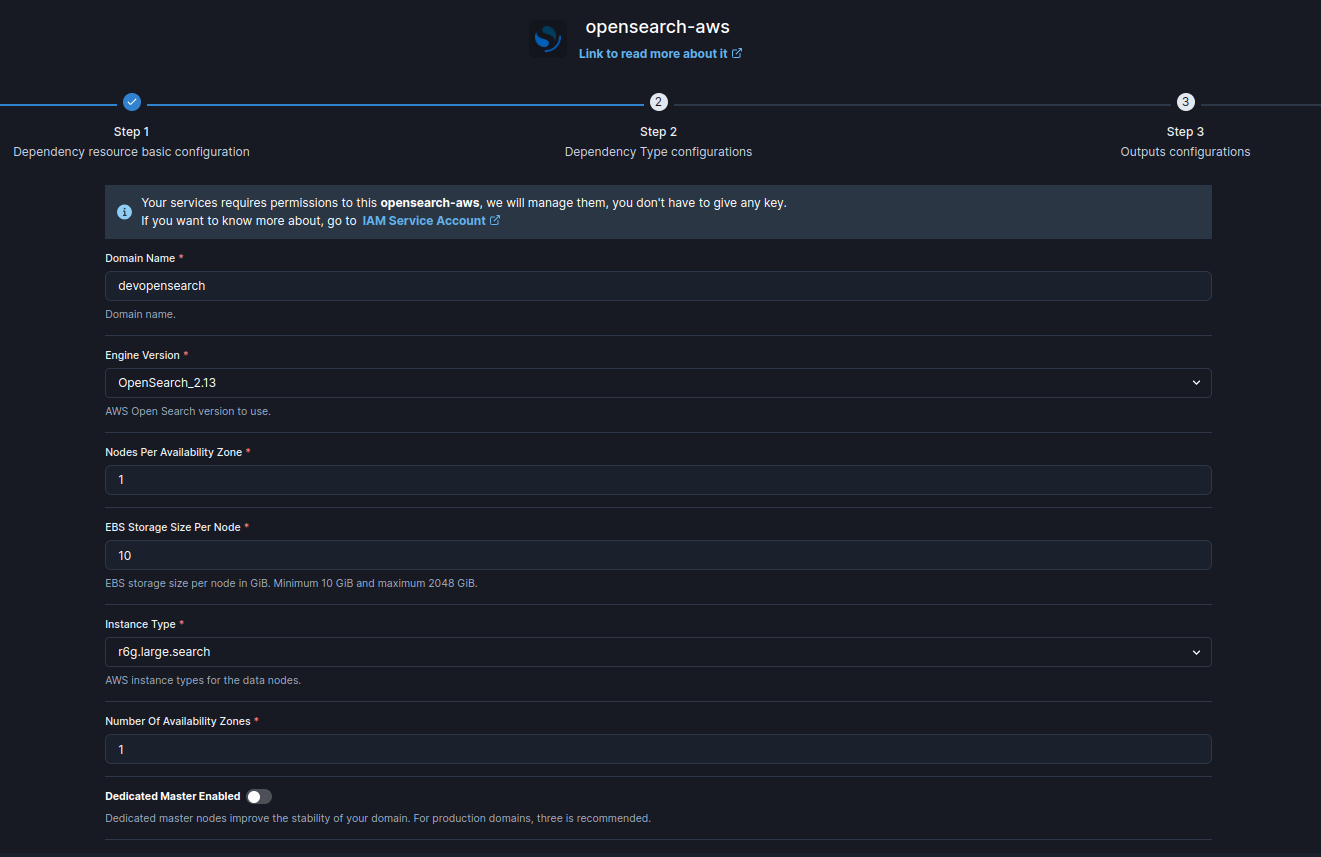AWS OpenSearch
SleakOps se integra con Amazon OpenSearch (anteriormente conocido como Amazon Elasticsearch Service), un potente motor de búsqueda y análisis diseñado para ayudarte a buscar, analizar y visualizar datos en tiempo real. Al utilizar OpenSearch en SleakOps, puedes implementar, gestionar y escalar rápidamente tu infraestructura de búsqueda, obteniendo valiosos conocimientos de tus datos.
Para más información sobre OpenSearch y sus capacidades, puedes consultar la Documentación de Amazon OpenSearch Service .
Preguntas Frecuentes
¿Cuáles son los casos de uso de OpenSearch?
OpenSearch se utiliza comúnmente para búsquedas de texto completo, análisis en tiempo real, monitoreo y observabilidad, y análisis de registros. También es ideal para potenciar funcionalidades de búsqueda en sitios web y aplicaciones.
¿Qué significa "Dedicated Master Enabled"?
Cuando está habilitado, SleakOps configura nodos maestros dedicados que ayudan a gestionar el dominio de OpenSearch. Proporcionan mayor estabilidad al separar las tareas de gestión de los nodos de datos. Esto es altamente recomendado para cargas de trabajo en producción.
¿Cuál es la configuración recomendada para nodos maestros en producción?
Para entornos de producción, SleakOps recomienda usar 3 nodos maestros dedicados para mejorar la estabilidad y el rendimiento de tu clúster de OpenSearch.
Configura tu OpenSearch
1. Agrega AWS OpenSearch como una Dependencia
Para integrar OpenSearch con SleakOps:
- En la consola de SleakOps, ve a la sección "Dependencias".
- Elige "SQS" de la lista de tipos de dependencias disponibles. Para más detalles, consulta Dependencias: Integrando Bases de Datos, Caché y Servicios de Mensajería.
2. Configura tu OpenSearch.
Al agregar OpenSearch como una dependencia en SleakOps, necesitas configurar varios atributos clave:

| Atributo | Descripción |
|---|---|
| Cola FIFO | Especifica el tipo de cola SQS: Standard Queue (para la mayoría de los casos) o FIFO Queue (si se requiere orden de mensajes). |
| Desduplicación FIFO | Solo para Colas FIFO, para evitar duplicados. |
| Periodo de Retención de Mensajes | Especifica la cantidad de tiempo que un mensaje será retenido en la cola si no ha sido consumido. |
| Tamaño Máximo de Mensaje | El tamaño máximo de un mensaje que puede ser enviado a la cola SQS. |
| Retraso en la Entrega en Segundos | El retraso entre el envío de un mensaje a SQS y su visibilidad en la cola. Sin retraso por defecto. |
| Tiempo de Espera para Recibir Mensajes | Determina cuánto tiempo esperará una llamada ReceiveMessage si no hay mensajes disponibles en la cola. |
| Timeout de Visibilidad | La duración durante la cual un mensaje permanece invisible después de que un componente lo lea desde la cola. |
| Cola de Mensajes Fallidos (DLQ) | Agrega una cola donde los mensajes que fallan en ser procesados múltiples veces son enviados para análisis adicional. |
3. Personaliza los nombres de tus variables para tu SQS.
Como se explicó, cuando se crea una dependencia, SleakOps genera un grupo de variables (vargroup) para contener todos los atributos necesarios.
En este paso, puedes cambiar el nombre de los atributos si es necesario.
SleakOps completa automáticamente los valores.
Después de este paso, tu dependencia está creada.
